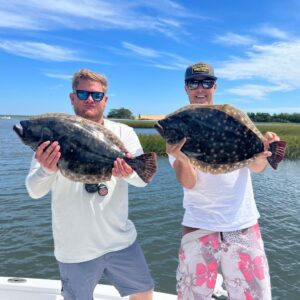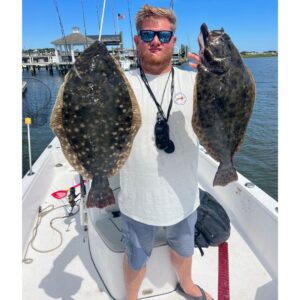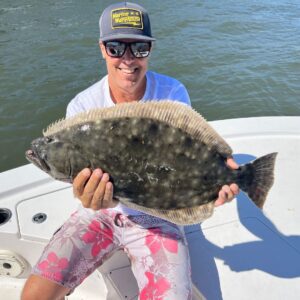Tidelines – October 2023
Most North Carolina flounder fishermen waited 50 weeks for opening day of the keeper season, but I had to wait the 50 weeks and a handful of morning hours, thanks to a MWF 8:00-9:00 class I had to teach before meeting Capt. Luke Moser, of Coastline Charters out of the Wrightsville Beach area, at the Trails End boat ramp to bang some docks in search of my first keeper flatfish of the 2023 season.
Luke had put in before sunrise, hoping to test the slowly improving trout bite in the area by throwing topwaters in the dark. The 25 mph winds were a little too much, so he quickly abandoned and went in search of bait. His preferred flounder baits are finger mullet, but a near high tide flooding the grasslands combined with those strong winds disrupting the water’s surface made mullet too hard to find. Pogies are a good second choice, though, according to Luke, and he found plenty in a boat basin.
When Luke picked me up, he had already hooked 8-9 fish from a total of three different docks, with the biggest measuring 20-inches and sharing a livewell with a bunch of live pogies.
We headed south, and our first dock was one he had been targeting all summer long for red drum. The flounder bycatch had been strong during those redfish trips, so we both hoped those fish would continue to cooperate on opening day.
“The flounder are going to be facing into the current, so I like to be on the down current side of the dock and throwing up current,” Luke explained as he readied himself with remote in hand and deployed the trolling motor.
“We can’t do that today,” he continued. “The wind is going in the opposite way of the tide, and this strong wind is more dominant than the tide, so we won’t be able to fish the docks on the side I want to.”
Luke grabbed a bait caster for himself and then handed me one. I hesitated a little, which he picked up on, so he pointed to a spinner in the leaning post’s rod rack. I didn’t hesitate this time, and we both headed up to the bow, each with a pogie in hand.
“I prefer a mullet,” Luke explained as he hooked the pogie up through the bottom of the mouth and out through the top of the head. “Pogies are just really fragile and don’t stay on the hook that great. They work fine, but I don’t like to constantly go through baits and hop back and forth to the livewell.”
We moved from the deeper-water end of the dock down to the shoreline fairly quickly, with at least one of us, if not both, pitching our baits up between every section under the dock. Luke hooked one, I hooked none, and only one fish on an entire pass was enough for Luke to pull the trolling motor and move us to the next dock. What a difference a dock makes.
Luke once again was the first to get a bite, and he was the second and maybe even the third, but then my time came. My pogie was no longer alive, but Luke said it didn’t matter.
“Just toss it up between the pilings and give it a little up and down motion to help make it look alive,” Luke continued. “It’s not really important if the pogie is alive or dead. Sometimes I’ll get a new bait, and sometimes I’ll just create a different puncture hole out of the top to get the dead bait to sit right, but what is important is to hook the dead bait in a way that keeps the mouth closed.”
About mid-dock, I felt my first thump of the 2023 flounder season. I flipped the bail, told Luke I had a bite so he could pause the trolling motor, and started—per my instructions from Luke—to give that fish a 15-second count before setting the hook.
My thump had been what every flounder fisherman wants to feel, an obvious bite that is unique to flounder, and the 15-second wait was full of building anticipation tempered by some nervous doubt. Was it a flounder or was it an undesirable species? Was I sure it was a thump or could it have been an oyster rock? Would it be a keeper flounder or one of the smalls?
While these questions are going on, I’m also wondering would it be okay if I didn’t wait the full 15-seconds? Could I just go for the hookset now? Should I go even longer than 15 seconds just to be sure? Should I lift up the rod tip a little to see if there’s weight or something clearly alive on the other end, or just let it sit?
Maybe I waited the full 15 seconds, but once I gave the strong hookset, as instructed, the rod bent over, the line felt heavy, and the fish on the end of my line scooted out and away from the pilings.
My very next pitch of a new bait generated another thump. This time, though, the thump was more subtle, but soon I was guiding an upgrade fish into the waiting landing net.
“In my experience and with the way that I fish,” Luke told me as I posed for a photo with my 23+-inch flatfish that would ultimately be my one keeper fish, “most of my big fish have been the tiniest little tap where I barely felt anything.”
While we pulled in at least one fish from each of the four docks we targeted that morning, that second dock was easily our most productive, producing two fish over 24”, two fish over 23” and eight or so in the 18-20” range.
When you read this Tidelines article, our two-week flounder season will be a memory, but Capt. Luke Moser, of Coastline Charters out of Wrightsville Beach, will still be chartering. He’ll just be targeting the October species of trout, redfish, sheepshead, albacore, and others. You can find out more about Luke and all of the fall options by visiting his website at www.coastlinechartersllc.com or by calling him direct at (336) 214-1968.
I hope you found your keeper fish, too, whether on opening day or on every single day of the flounder season, and hopefully we all won’t have to wait 50 weeks to feel the thump, set the hook, and bring one of those delicious fish over the gunnel.



